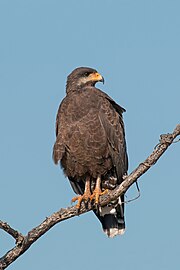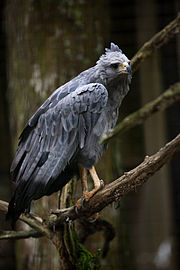Buteogallus
| Buteogallus Temporal range: Middle Miocene to present
| |
|---|---|
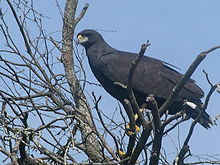
| |
| Great black hawk (Buteogallus urubitinga) | |
| Scientific classification | |
| Domain: | Eukaryota |
| Kingdom: | Animalia |
| Phylum: | Chordata |
| Class: | Aves |
| Order: | Accipitriformes |
| Family: | Accipitridae |
| Subfamily: | Buteoninae |
| Genus: | Buteogallus Lesson, RP , 1830
|
| Type species | |
| Buteogallus cathartoides[1] = Falco aequinoctialis Lesson, 1830
| |
| Species | |
|
see text | |
| Synonyms | |
|
Alectromorphnus Heine & Reichenow, [1890] | |
Buteogallus is a
Most of the species have a characteristic tail pattern. This consists of a black base, a wide white middle band, a wide black band, and a quite narrow white band on the feathertips that is often hard to discern or may be lost when the feathers are very worn. Only the white-necked hawk and the rufous crab hawk have a very different tail patterns (see also below).
Taxonomy and species
The genus Buteogallus was introduced in 1830 by the French naturalist
| Common name | Scientific name and subspecies | Range | Size and ecology | IUCN status and estimated population |
|---|---|---|---|---|
| Slate-colored hawk | Buteogallus schistaceus (Sundevall, 1850) |
Brazil, Bolivia, Peru, Ecuador, Colombia, Venezuela, and French Guiana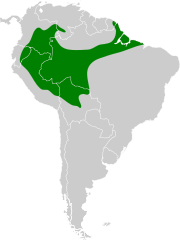
|
Size: Habitat: Diet: |
LC
|
| White-necked hawk | Buteogallus lacernulatus (Temminck, 1827) |
Brazil
|
Size: Habitat: Diet: |
VU
|
| Rufous crab hawk | Buteogallus aequinoctialis (Gmelin, JF, 1788) |
eastern Venezuela, Trinidad and Tobago to southern Brazil
|
Size: Habitat: Diet: |
NT
|
| Common black hawk | Buteogallus anthracinus (Deppe, 1830) Five subspecies
|
Southwestern United States through Central America to Venezuela, Peru, Trinidad, and the Lesser Antilles
|
Size: Habitat: Diet: |
LC
|
| Cuban black hawk | Buteogallus gundlachii (Cabanis, 1855) |
Cuba
|
Size: Habitat: Diet: |
NT
|
| Great black hawk | Buteogallus urubitinga (Gmelin, JF, 1788) Two subspecies
|
Mexico through Central America to Peru, Tobago and northern Argentina.
|
Size: Habitat: Diet: |
LC
|
| Savanna hawk | Buteogallus meridionalis (Latham, 1790) |
Panama and Trinidad south to Bolivia, Uruguay and central Argentina
|
Size: Habitat: Diet: |
LC
|
| Chaco eagle | Buteogallus coronatus (Vieillot, 1817) |
southern and central Brazil, Bolivia, Paraguay and its range extends to Northern Patagonia in Argentina
|
Size: Habitat: Diet: |
EN
|
| Solitary eagle | Buteogallus solitarius (Tschudi, 1844) Two subspecies
|
Mexico and Central and South America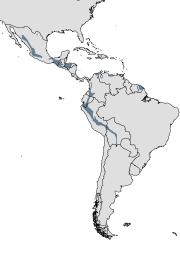
|
Size: Habitat: Diet: |
LC
|
The solitary eagles (formerly
For a long time various systematists have proposed moving the slate-colored hawk to Buteogallus. Together with the crab hawks and solitary eagles form a sequence of plumage patterns that nicely agrees with the DNA-based phylogeny: the slate-colored hawk looks very much like a smaller, shorter-legged and lighter common black hawk. The case of the white-necked hawk is more puzzling. It is visually and
The placement of the peculiarly
Fossil record
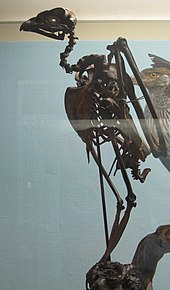
The
- †Buteogallus enectus (Middle Miocene; Sheep Creek, Sioux County, USA)
- †Aquila
- †Buteogallus fragilis (Late Pleistocene; Southwestern USA) – formerly in Buteo or Geranoaetus
- †Buteogallus milleri (Late Pleistocene of Southwestern, USA) – formerly in Buteo or Geranoaetus
- †Buteogallus royi (Late Pleistocene of Cuba)
- †prehistoric) – formerly in Aquila or Titanohierax
- †Buteogallus daggetti (prehistoric)
- †Buteogallus woodwardi (Late Pleistocene, Southwestern USA) - formerly Amplibuteo
- †Buteogallus hibbardi (Late Pleistocene, Peru) - formerly Amplibuteo
- †Buteogallus concordatus (Late Pliocene of Florida) - formerly Amplibuteo
- †Buteogallus irpus (Late Pleistocene of Cuba and Dominican Republic)
References
- ^ "Accipitridae". aviansystematics.org. The Trust for Avian Systematics. Retrieved 2023-07-26.
- ISBN 978-0-9568611-1-5.
- ^ Mayr, Ernst; Cottrell, G. William, eds. (1979). Check-List of Birds of the World. Vol. 1 (2nd ed.). Cambridge, Massachusetts: Museum of Comparative Zoology. p. 356.
- ISBN 978-1-4081-2501-4.
- Rasmussen, Pamela, eds. (August 2022). "Hoatzin, New World vultures, Secretarybird, raptors". IOC World Bird List Version 12.2. International Ornithologists' Union. Retrieved 7 December 2022.
- ^ PMID 16464261.
- PMID 19635577.
- ^ Bierregaard, R. O. Jr.; Kirwan, G. M.; Christie, D. A. (2018). "White-necked Hawk (Buteogallus lacernulatus)". In del Hoyo, J.; Elliott, A.; Sargatal, J.; Christie, D. A.; de Juana, E. (eds.). Handbook of the Birds of the World Alive. Retrieved 17 April 2018.





